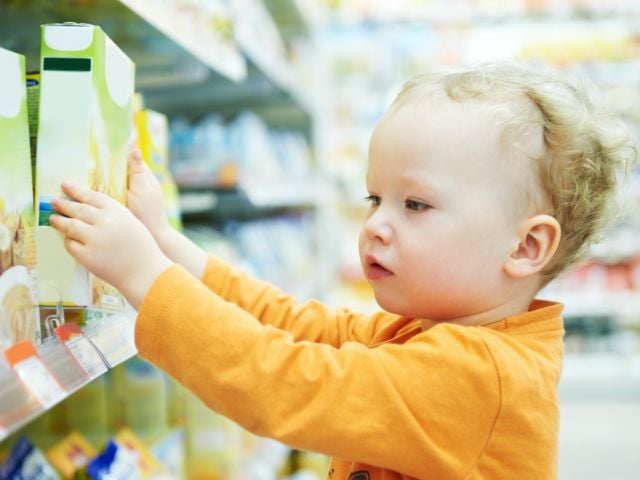
Processed food and drinks often use artificial dye to boost their appeal, especially if they’re marketed to children and teens. But these colorants have a range of health risks, so some states are taking the lead on legislation to get them out of food and drinks.
The good news: Removing these dyes from the wide variety of products they’re used in will reduce those health risks, with no change to the taste or availability of what you eat and drink.
Tens of thousands of products in EWG’s Food Scores database, which rates the health hazards of packaged food and drinks, contain artificial colors such as Blue Dye No. 1, Blue Dye No. 2, Green Dye No. 3, Red Dye No. 40, Yellow Dye No. 5 and Yellow Dye No. 6.
These colorants are associated with a range of health risks.
- Blue 1: A study observed developmental delays and changes in behavior in animals. Another study found that when combined with other additives, this dye was associated with harm to nervous system cells.
- Blue 2. Consumption of this chemical caused an increased incidence of tumors in rats, though limited individual studies have been conducted.
- Green 3. An animal study found a possible increase in bladder tumors but there are limited individual studies.
- Red 40. Studies show this dye harms children’s brains during critical periods of development.
- Yellow 5. In children with suspected hyperactivity, as little as one milligram of this dye can cause irritability and restlessness and disturb sleep.
- Yellow 6. Studies find this dye may be contaminated with the cancer-causing chemical benzidine or other harmful substances.
Despite evidence these dyes are harmful, they continue to be allowed in foods in the U.S. In fact, the Food and Drug Administration has not reviewed them for decades.
States taking action
With federal government regulations falling short in protecting consumers from harmful ingredients in food, states are beginning to step up.
In September 2024 California enacted a law co-sponsored by EWG, banning six harmful dyes – Blue 1 and 2, Green 3, Red 40 and Yellow 5 and 6 – from food served in the state’s public schools.
Since then, more than 15 other states have introduced legislation to regulate the use of these six dyes in food and beverages.
One such bill, H.B. 2354 in West Virginia, bans the sale of foods containing the dyes Red 3, Red 40, Yellow 5, Yellow 6, Blue 1, Blue 2 and Green 3. It was signed into law on March 24.
Another, H.B. 641 in Florida, would require a warning label on the packaging of food and drink products containing Blue 1, Blue 2, Green 3, Red 40, Yellow 5, Yellow 6 and titanium dioxide.
The warning label requirement is similar to the approach the European Union takes to regulate these dyes.
What does this mean for me?
You may wonder how all of this proposed and enacted legislation will affect the food and drink you consume.
To answer this question, we can look to other countries, in particular what their regulators decided after assessing the science about dyes.
In most instances, the countries set stricter standards, without affecting foods and beverages. Because of safety concerns, the EU does not allow the use of Green 3 and has banned Red 3 in foods, with the narrow exception of maraschino cherries.
The EU, since 2010, requires foods containing other synthetic food dyes, including Red 40, Yellow 5 and Yellow 6, to carry a warning label stating they “may have an adverse effect on activity and attention in children.”
Despite these stricter laws, consumers in Europe enjoy the same foods as those in the U.S.
In response to the warning label requirement, many manufacturers chose to reformulate their products so they no longer use those dyes. Companies selling these same products with synthetic dyes in the U.S. could also easily reformulate.
In 2024 EWG conducted a taste test of Froot Loops cereal made in the U.S., containing synthetic dyes, and Froot Loops from Canada, without the synthetic dyes. They tasted the same.
Even without these dyes, products not only keep their flavor, but can also still look vibrant. There are cost-effective alternatives to many colors, including:
- Blue. Alternatives to Blue 1 and Blue 2 include plant-derived colorants like spirulina, butterfly pea flower extract, anthocyanin and red cabbage.
- Green. Alternatives to Green 3 include plant-derived colorants like spirulina, chlorophyll and matcha.
- Red. Alternatives to Red 40 include plant-derived colorants like anthocyanina, black/purple carrot, elderberry, purple sweet potato and beet.
- Yellow. Alternatives to Yellow 5 and Yellow 6 include plant-derived colorants like annatto, saffron, turmeric, beta-carotene and paprika.
What can I do?
There’s a short wait for dye-free food and drink, as companies reformulate their products to adhere to the recent state laws. In the meantime, if you want to moderate your daily intake of food dye or lower it as much as possible, you can:
- Consult EWG’s Food Scores. The database accounts for the presence of food dyes when scoring food based on nutrition, ingredient and processing concerns. On the go, use our Healthy Living app to find products without artificial color.
- Read ingredient labels. The FDA requires companies to list food dyes on product labels. Try to avoid products containing artificial dye.
- Avoid ultra-processed foods when possible. Most food dyes are found in processed food and drinks, so limiting your consumption can improve long-term health.



